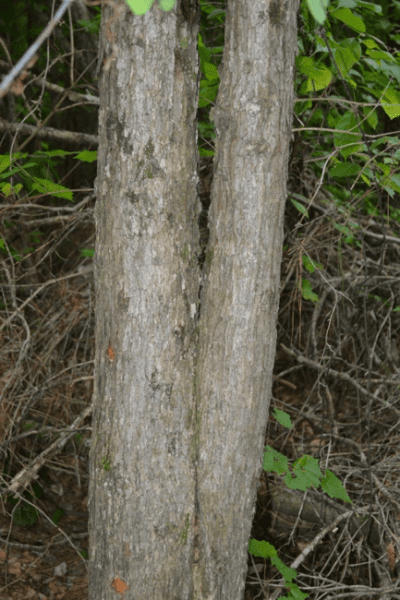Landscaping

It is disappointing to see large trees and limbs damaged by the wind. There is no way to avoid damage with some storms. However, training ornamental trees can help. Training trees is something that is done over a period of many years and something that may be hard to correct if neglected or done improperly. The following information covers training larger tree species such as oak, maples, ash, hickory, and magnolia.
Central Leader Branches

This tree developed an upright branch with a narrow crotch angle inches from the ground. This tree could have easily been trained into one central leader if it were noticed and pruned earlier.
From the first year the tree begins to grow, branches can compete for the central leader position. All trees are not equal with regards to developing competing central leaders. Some trees naturally retain a central leader growth habit, while others commonly have branches competing for the central leader position.
If two or more branches start to grow in the upright position, a narrow crotch angle will form. A storm can damage any tree, but large trees with the narrow crotch angles are the ones most susceptible to falling. These upright limbs are not well attached to the trunk and are easily blown down by winds.
A tree with more than one central leader is weak because of bark inclusion. This is when the bark is included in the union between a limb and the trunk. Just because the bark grows together from an upright branch to the trunk does not mean the wood underneath the bark is attached to the trunk. It is common to see included bark when more than one limb competes for the central leader position.
Management
Checking for competing central leader branches begins in the seedling stages and continues until the tree gets as high as someone can reach. If there are two or more branches competing with each other, all but one of them needs to be removed or pruned back to an outward growing branch. A pole saw may help reach the higher branches. Note. Do not remove all the branches on the tree, just the branch that may be competing for the central leader position.
Trees can develop another central leader as they grow, but more often it begins near the ground and can be easily corrected while the tree is young. The younger the branch when it is pruned, the faster bark will grow over the wound and protect the tree.
Evenly Spaced Branches
How the branches are spaced around the trunk of a tree is important as well. While this can be hard to manage, it is recommended for branches to be evenly spaced around a tree and not directly above another branch. Also, these evenly spaced branches should not begin at the same point on the trunk. If one branch is growing on one side of the trunk, you do not want another limb growing on the opposite side of the trunk. It would be nice to have 18 inches or more up the trunk before a branch on the opposite side is allowed to grow.

